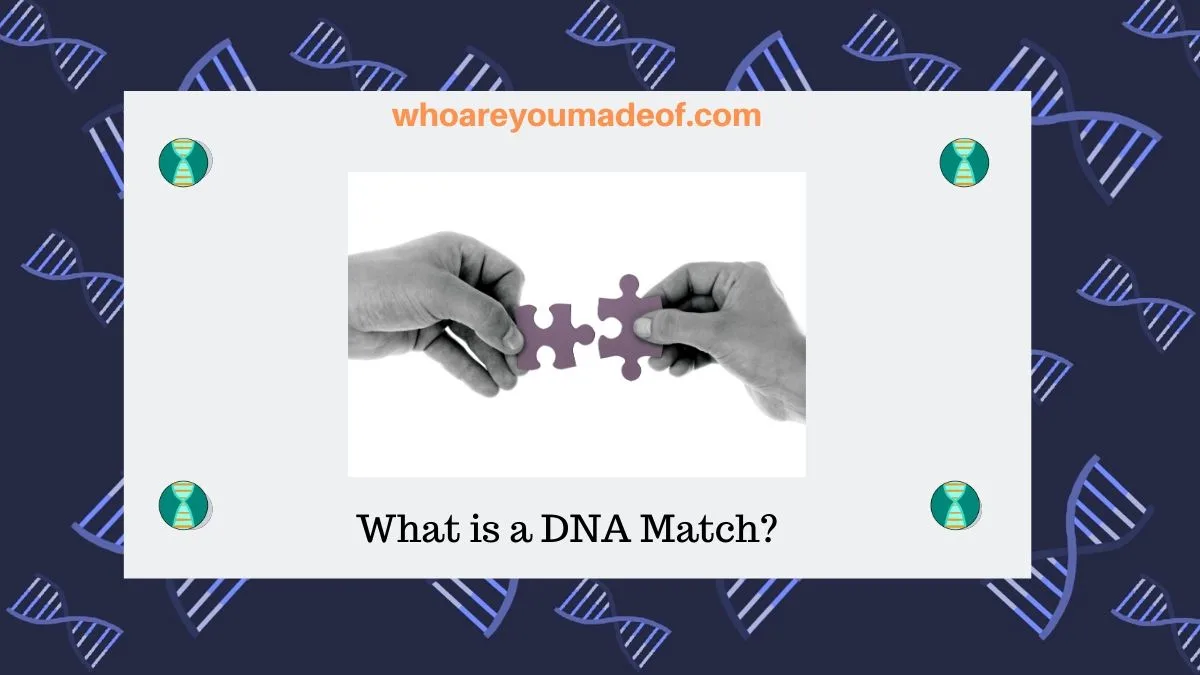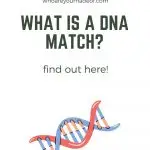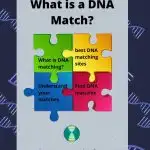Do you want to know what a DNA match is? In this post, learn the answer, as well as how DNA testing companies are able to provide you with a list of your DNA matches.
Plus, find out which DNA matching sites are the best.
In addition, at the bottom of this post, I'll provide basic tips for how to understand your DNA matches and give you helpful links to more posts about DNA matches.

DNA matches are, by far, the best and most exciting aspect of DNA results. I have learned a lot from my DNA matches, and my goal is that this post helps you to understand more about how DNA matching works.
What is an autosomal DNA match?
An autosomal DNA match is a person who has a shared genetic sequence on a numbered chromosome that may indicate at least one common ancestor.
When we talk about DNA matching, we are almost always referring to autosomal DNA matches. An "autosome" is one of our 22 numbered chromosomes.
We have two copies of each chromosome. One copy is the maternal copy, and the other copy is the paternal copy.
Each person inherits 50% of their DNA from their mother and 50% of their DNA from their father. The 50% of our DNA that we inherit from our mother is made up of half of our mother's DNA and is passed down on the maternal copy each autosomal chromosome.
The same occurs with DNA we inherit from our father.
Even though half of our parents' DNA is inherited in relatively random fashion through a process called recombination, large clumps of DNA are passed down intact for several generations. These clumps of DNA are called "DNA segments".
How do they determine your DNA matches?
When we submit our DNA samples to DNA testing companies for genotyping, they use advanced technology to determine our genetic makeup. Part of this process of preparing our DNA results includes comparing our DNA to the DNA of other customers in order to identify identical DNA segments.
When the DNA testing company's software identifies segments that match between two people, we say that they are DNA matches. The DNA testing company will count the number of matching DNA segments and add up number of the centimorgans, which is a unit of measurement for measuring genetic distance, that make up the DNA segments in order to estimate the relationship between the two individuals.
Below, you can see an example of my DNA match list from Ancestry DNA. DNA matches are very accurate, especially for relatively close relatives (i.e. 3rd cousins and closer).

Most of the people further down on our DNA list are related to us in some way, but in order to verify the relationship we will need to do genealogical research.
It's important to note that as your DNA testing company receives more DNA samples from new customers, they will compare your DNA with their new samples. If there is a match, you will gain a new DNA match on your list.
What are the best DNA matching sites?
Do you think you'd like to find DNA matches? I'm very excited! As I mentioned before, DNA matches are really a lot of fun to work with.
There are four main companies that I highly recommend for finding DNA matches. The top companies for finding lots of DNA matches are as follows: Ancestry DNA, 23andMe, My Heritage DNA, and Family Tree DNA.
You can order your DNA test from any of these companies to get started with DNA matches by using any of the following links. I will get a (very!) small commission at no extra cost to you, which helps me support this site:
If you have already done a DNA test and are interested in getting more DNA matches, I recommend uploading your DNA to the following sites:
How to understand your DNA matches
When you first take a look at your DNA match list, no matter which company you used to do your test, you should know that your matches are generally listed in order of most closely related to you. Your more distant relatives can be found as you scroll down your list.
The people who are on your DNA match list - especially those at the top - are definitely related to you. In order to figure out exactly how they are related, however, you might need to know a little bit about your family tree and that of your DNA match.
If you have already done a DNA test and you have a list of DNA matches you'd like to learn more about, I highly recommend reading some of the posts listed below. I've written hundreds of posts about DNA matches and DNA results, so you can also take a look around this site for other useful information.
I have included here additional links to some of the best posts about DNA matches on this website:
- Beginner's Guide to Shared Centimorgans
- How to analyze your DNA matches
- How can DNA matches help build a family tree?
- How is your DNA match related? Here's a checklist
If you want to read a post that details exactly how to understand DNA matches from the company you already did your test with, the following posts are useful:
- How to understand your DNA matches: Ancestry DNA
- How to understand your DNA matches: 23andMe
- How to understand your DNA matches: Family Tree DNA
- How to understand your DNA matches: My Heritage DNA
- How to understand your Gedmatch One-to-Many results
Conclusion
I hope that this post helped you learn more about DNA matching, where to find DNA matches, and how to understand your matches. If you have any questions about something that you read in this post, or if you would like to share your own experience with DNA matches, I would love for you to join us in the discussion below.
Thanks for stopping by today!




What is the Philippines DNA Ethnicity on Ancestry? - Who are You Made Of?
Friday 5th of March 2021
[…] ethnicity estimates are cool, the real gem in your DNA result is your DNA match list. Hidden among your DNA matches is the real key to figuring out how far back your Philippines […]